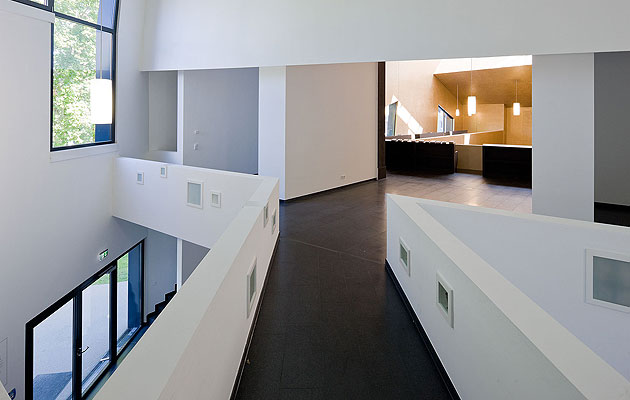|
|
||
|
“It’s a building which wants to be approached,” says Manuel Herz about his recently completed Jewish Community Centre in Mainz, Germany. It’s a bold building, with an abstract, expressive form, clad in shimmering green ceramic tiles. “It’s not a building that exhausts itself in one view.” A project like this is of course an insertion into a long, illustrious but often terrible history. In early medieval times, Mainz was a centre of Talmudic study and a great intellectual influence on the culture of European Judaism. On the site of the new centre there was previously a synagogue, but it was destroyed by the Nazis in 1938. For a long time after the war the Jewish population of the city remained tiny, but over the past decades it has risen steadily, necessitating the new facilities.
credit Iwan Baan In plan the building mostly follows the line of the street, only breaking away from it with the prayer room, which is symbolically oriented towards the east and Jerusalem. This creates two outdoor spaces: a small synagogue garden and a larger public space which it is hoped will function as the neighbourhood square. Fragmented remains of the previous synagogue have been erected in the square, but this was on the insistence of the older generation in the community rather than the architect. “It’s extremely important that the people are not inhibited from approaching the building – it was essential that this space was truly public,” says Herz. “The way the building meets the site is not articulated, there’s nothing like a plinth, it’s not raised out of the very ordinary urban context. I wanted to give it an everyday-ness, a naturalness.” Perhaps not unsurprisingly for a building containing a synagogue, Herz sees a conceptual approach to the formal qualities of text and writing as important. “The Jewish religion never developed a tradition of architecture or architectural style, unlike Christianity,” he explains. “The Jews – in a certain way – developed a very specific understanding of space, but they did this through the medium of writing and text, specifically the Talmud.” The centre thus works on many levels – for example, the jagged elevation rises up partly so that the building makes urban sense set against the dense housing blocks surrounding it, while inside it provides expansive ceilings above certain functions. But at the same time it has an allegorical meaning: “The precise articulation in a very abstracted way articulates or traces the precise outline of the word Q’dushah, which means raising or making sacred,” says Herz. “It points to the fact that in Judaism there are no technically holy spaces – only through use does a space become sacred.” Overall the design tries to balance the quotidian with the flamboyant, and the importance of paying proper respect to history with a desire to make a friendly and accessible building for the future of Mainz. For example, when asked about the meaning of the cladding, Herz says: “There’s no symbolism to it, it’s just an amazing material which plays extremely well with light.” |
Image Iwan Baan
Words namenamename |
|
|
||
|
credit Iwan Baan |
||




















